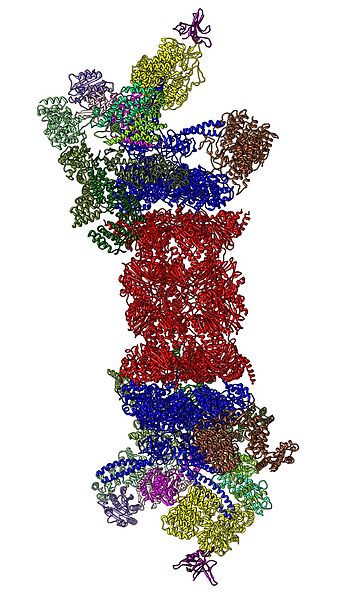The 70 kilodalton heat shock proteins are a family of conserved ubiquitously expressed heat shock proteins. Proteins with similar structure exist in virtually all living organisms. Intracellularly localized Hsp70s are an important part of the cell's machinery for protein folding, performing chaperoning functions, and helping to protect cells from the adverse effects of physiological stresses. Additionally, membrane-bound Hsp70s have been identified as a potential target for cancer therapies and their extracellularly localized counterparts have been identified as having both membrane-bound and membrane-free structures.
Structure of the ATPase fragment of a 70K heat-shock cognate protein.
(a) The Hsp70s schematic domains. The Hsp70s consist of two high conserved functional domains including an NBD and a C‐terminal substrate‐binding domain (SBD), also an EEVD‐motif at C‐terminal. The NBD contains the ATP/ADP pocket that binds and The SBD contains a substrate‐binding pocket that interacts with extended polypeptides as substrate, an α‐helical subdomain from the C‐terminal side of SBD forms a flexible lid. EEVD‐motif participates in binding to co‐chaperones and other HSPs. (b) the complete amino acid sequence of human Hsp70 (UniProtKB identifier: P0DMV8) as a major stress‐inducible member of the Hsp70 family. (c) Secondary structures of Hsp70 virtualized using VMD 1.9.1 software. Hsp70, heat shock protein 70 kDa; NBD, N‐terminal nucleotide‐binding domain; SBD, substrate binding domain at C‐terminal.

The function of Hsp70 in both (re) folding and degradation of misfolded client protein. (a) Schematic of the Hsp70 ATP–ADP cycle for (re) folding of client protein which causes a conformational change of the chaperone, ATP hydrolysis, and exchange. (b) Hsp70–CHIP complex that promotes client protein ubiquitination and proteasomal degradation. CHIP interacts with the TPR domain of Hsp70 and acts as a ubiquitin ligase for clients. CHIP, chromatin immunoprecipitation; Hsp70, heat shock protein 70 kDa; TPR, tetratricopeptide‐repeat domain
Proteasomes are protein complexes which degrade unneeded or damaged proteins by proteolysis, a chemical reaction that breaks peptide bonds. Enzymes that help such reactions are called proteases.
Cartoon representation of the 26S proteasome.




